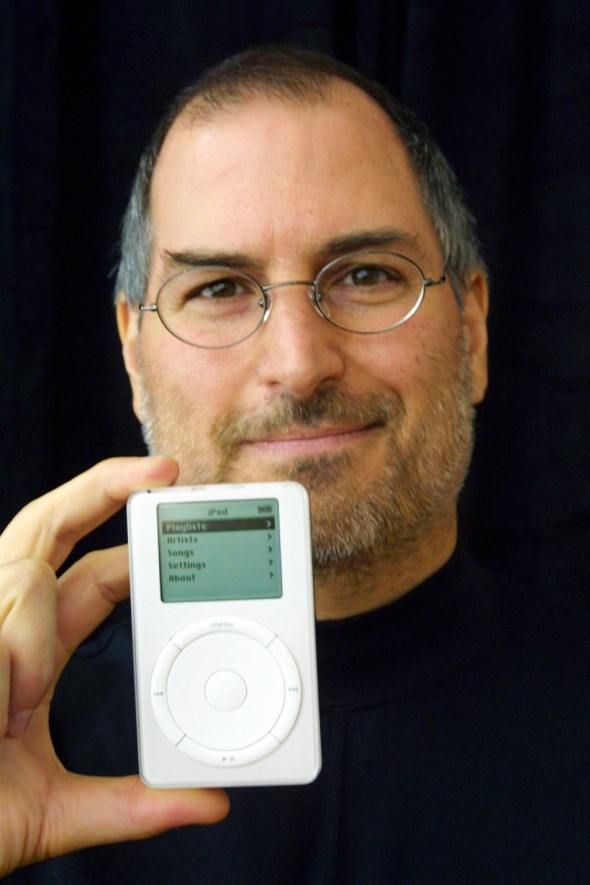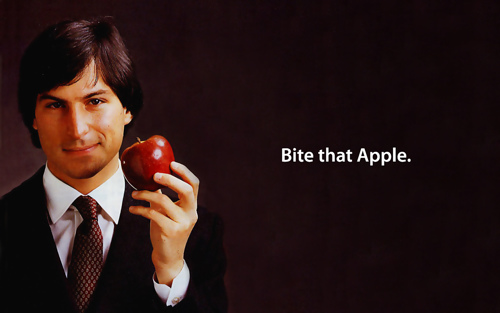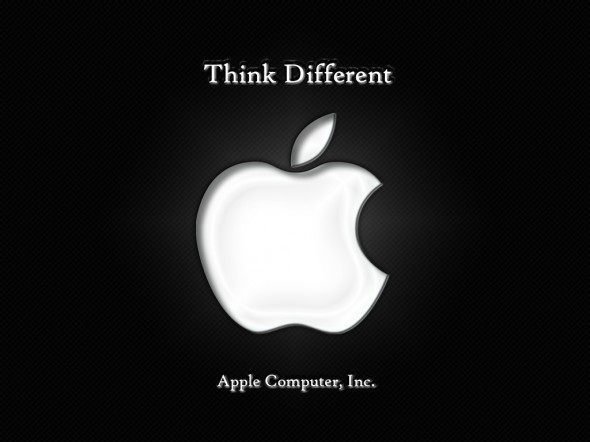Presentation for Humphrey Seminar on December 5
“Jobs … became the greatest business executive of our era, the one most certain to be remembered a century from now. History will place him in the pantheon right next to Thomas Edison and Henry Ford.”
Walter Isaacson
Time, October 12, 2011
 (Crunchbase)
(Crunchbase)
Steve Jobs’ and Apple’s brief timeline:
1976: Apple Computer is formed on April Fool’s Day, shortly after Wozniak and Jobs create a new computer circuit board in a Silicon Valley garage. A third co-founder, Ron Wayne, leaves the company after less than two weeks. The Apple I computer goes on sale by the summer for $666.66.
1980: Apple goes public, raising $110 million in one of the biggest initial public offerings to date.
1985: Jobs and Sculley clash, leading to Jobs’ resignation. Wozniak also resigns from Apple this year.
1995: The first Mac clones go on sale. Microsoft releases Windows 95, which is easier to use than previous versions and is more like the Mac system. Apple struggles with competition, parts shortages and mistakes predicting customer demand. Pixar’s “Toy Story,” the first commercial computer-animated feature, hits theaters. Pixar goes to Wall Street with an IPO that raises $140 million. The company had a dwindling 4 percent share of the PC market and annual losses exceeding $1 billion
In the face of Apple going down in the doldrums as a company, Steve Jobs comes back.
1997: Jobs Comes Back. Introduces Apple Store.
His title was interim CEO. He foreshadows the marketing hook for a new product line by calling himself “iCEO” and puts an end to Mac clones.
Introduces the Apple Store, which lets consumers custom-order Apple products directly from the company online.
1998: Apple Profits Again. iMac desktop introduced.
It shakes up the personal computer industry in 1998 with the candy-colored, all-in-one iMac desktop. It especially grabbed the industry by the visual appeal of how the original models which shaped like futuristic TVs.
2000: Jobs becomes CEO, no longer “interim”.

(IBTimes)
2001: Year of Incredible Firsts! The iPod, Computers with OS X, iTunes and Apple Stores.
Ipod
“With iPod Apple has invented a whole new category of digital music player that lets you put your entire music collection in your pocket and listen to it wherever you go…With iPod, listening to music will never be the same again.” Apple’s shipped more than 300 million iPods as of October 2011.
OS X
OS X, being the modern Mac operating system. It was codenamed Cheetah, and each new iteration has been named after a member of the big cat family.
iTunes
It was during this year that Apple also released the wildly popular iTunes music player software.
“iTunes is miles ahead of every other jukebox application, and we hope its dramatically simpler user interface will bring even more people into the digital music revolution.”
Apple Retail Stores
Opens Apple’s first retail stores with the store designs and personal sales methods proved to be tremendously popular. Apple was running 330 stores worldwide as of July 2011.
2003: iTunes Music Store launched with 200,000 sells 1m songs in first week.
Apple launches the iTunes Music Store with 200,000 songs at 99 cents each, giving people a convenient way to buy music legally online. It sells 1 million songs in the first week.
Apple sold 10 billion songs via iTunes as of February 24, 2010, and it counted 225 million iTunes accounts with credit cards as of June 2011.
2005: iPod line expands through shrinking – The Shuffle & Nano.
“iPod Shuffle is smaller and lighter than a pack of gum and costs less than $100…With most flash memory music players, users must use tiny displays and complicated controls to find their music; with iPod Shuffle you just relax, and it serves up new combinations of your music every time you listen.”
Later that year, Apple expands the iPod line with the tiny Nano and an iPod that can play video.
“iPod Nano is the biggest revolution since the original iPod…iPod Nano is a full-featured iPod in an impossibly small size, and it’s going to change the rules for the entire portable music market.”
2007: The iPhone and Fans going wild, along with iPod Touch
Apple releases its first smartphone, the iPhone. Crowds camp overnight at stores to be one of the first to own the new device.
“iPhone is a revolutionary and magical product that is literally five years ahead of any other mobile phone…We are all born with the ultimate pointing device–our fingers–and iPhone uses them to create the most revolutionary user interface since the mouse.”
Apple owns 19.1 percent of the smartphone market as of August 2011, having shipped 108 million iPhones worldwide as of March 2011.
“The iPod Touch is a landmark iPod, ushering in a whole new generation of features based on its revolutionary multitouch interface and built-in Wi-Fi wireless networking…People are going to be amazed at how thin it is and how much it does.”
2010: iPad released, induces new category of touch-screen tablet computers.
Apple sells 15 million of its newest gadget, the iPad, in nine months, giving rise to a new category of modern touch-screen tablet computers.
Jan 2011: Jobs steps down.
In a memo to Apple employees, Jobs announces a medical leave with no set duration. Cook again steps in to run day-to-day operations. Jobs retains CEO title and remains involved in major decisions.
Aug 2011: Jobs to resign as CEO
Apple announces that Jobs is resigning as CEO. Cook takes the CEO title, and Apple names Jobs chairman.
As a result of Jobs’ efforts during his second term in company, Apple’s market capitalization went from $3 billion at the start of 1997 to $350 billion today. It is more than the valuation of Microsoft and Dell combined, making it the second most valuable company in the world
It turned out that a company’s design talents, software prowess, and ability to exploit cheap but high-quality manufacturing in Asia could produce gorgeous and accessible consumer electronics.

Regarding his management Style:
He is not an inventor. He did not invent many thinks outright, but he was a master at arranging ideas, ‘link the dots’ art and technology in ways that repeatedly invented the future.
He has dual vision. He looked at the big picture and mastered the details.
He also has binary view of the world: something was either “the best thing ever” or it totally sucked.
He has need for control Created a digital-hub strategy, with a variety of portable devices and mange your digital content. The iPod, for example, was part of a closed and tightly integrates system. To use it, you had to use Apple’s iTunes software and download content from its iTunes Store. The result was that the iPod, like the iPhone and iPad that followed, was an elegant delight, in contrast to the kludgy rival products that did not offer such a seamless end-to-end experience.
He is sure that taking care of customers means really a lot: “They’re busy doing whatever they do best, and they want us to do what we do best. Their lives are crowded. They have other things to do than think about how to integrate their computers and devices.”
(AppAdvice)
References:
Barry Moltz, Steve Job’s style: Everything we know about Managing is wrong, Open Forum: Powering small business success, Nov. 25, 2011. Retrieved on Dec. 4, 2011 from: http://www.openforum.com/articles/steve-jobs-style-everything-we-know-about-managing-is-wrong
James Rainey, On the Media: Steve Jobs and Apple vs. a free press, Los Angeles Times, Oct. 7, 2011. retrieved on Dec. 4, 2011 from: http://www.latimes.com/entertainment/news/la-et-onthemedia-20111008,0,7256248.column
Ned Potter, Steve Jobs dies, ABC News, Oct. 5, 2011, retrieved on Dec. 4, 2011 from:
Robert Verganti, Steve Jobs and Management by Meaning, Harvard Business Review, Oct 7, 2011. Retrieved on Dec. 4, 2011 from
http://blogs.hbr.org/cs/2011/10/steve_jobs_and_management_by_m.html
Sarah Mclnerney, Steve Jobs: Unconventional Leader, The Sunday Morning Herald, Oct. 7. 2011. Accessed on Dec. 4, 2011 and retrieved from http://www.smh.com.au/executive-style/management/steve-jobs-an-unconventional-leader-20111007-1lcmo.html
Walter Icon, American Icon: Steve Jobs, Time. October 12, 2011
No Author, CNET, October 2011, Steve Jobs: A timeline,
http://news.cnet.com/8301-13579_3-20116374-37/steve-jobs-a-timeline/
Accessed December 2 2011
No Author, The Telegraph, Oct 2011, Steve Jobs:
timeline
http://www.telegraph.co.uk/technology/steve-jobs/8810045/Steve-Jobs-timeline.html
Accessed December 2, 2011
No Author: Steve Jobs, from Wikipedia. Retrieved on Dec. 4.

